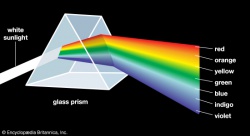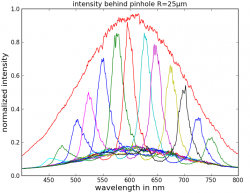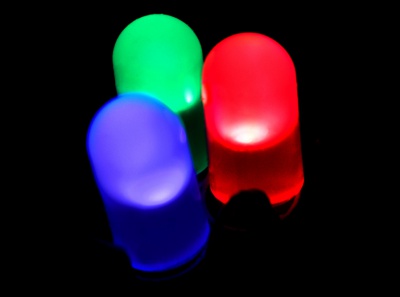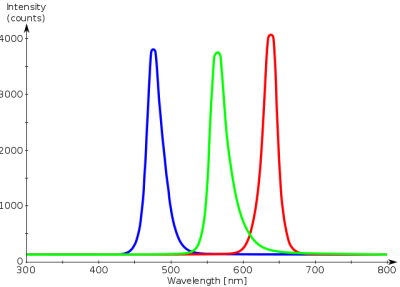Difference between revisions of "Ch7 lec 2"
| Line 2: | Line 2: | ||
==Additional Light Lab Info== | ==Additional Light Lab Info== | ||
| − | In our lab discussion i did not introduce you to the "photodiode array" (PDA) <-- not "public display of affection" --> instrument. A PDA is very similar to an electronic version of a prism. | + | In our lab discussion i did not introduce you to the "photodiode array" (PDA) <-- not "public display of affection" --> instrument. A PDA is very similar to an electronic version of a "glass prism." A prism separates the wavelengths of light into the individual color components; when a rainbow is observed, the tiny water droplets are acting as a prism. If we were to direct "white" light into the PDA (which contains a prims and more), then you could measure/collect a "spectrum" similar to the "broad," featureless spectrum (red) on the far right figure...note the wavelengths are in nanometers (nm). This figure is complicated by the fact that these authors used a technique to separate the light prior to it entering the PDA, so that is why there are all of the other "narrow" spectra also shown. |
{| | {| | ||
|[[File:Light_dispersion_conceptual_waves.gif|400px]]||[[File:prism_02.jpg|250px]]||[[File:The-spectrum-of-a-white-light-source-is-scanned-with-the-Alvarez-Lohmann-system-In-this.png|250px]] | |[[File:Light_dispersion_conceptual_waves.gif|400px]]||[[File:prism_02.jpg|250px]]||[[File:The-spectrum-of-a-white-light-source-is-scanned-with-the-Alvarez-Lohmann-system-In-this.png|250px]] | ||
|} | |} | ||
| − | + | Sorry, i know this is a little confusing...hand in there...here is another example... | |
| − | [[File: | + | {| |
| − | + | |[[File:RBG-LED.jpg|400px]]||[[File:RGB_LED_Spectrum2.png|400px]] | |
| − | + | |} | |
| − | [[File: | ||
[[File:RBG-LED.jpg|400px]] | [[File:RBG-LED.jpg|400px]] | ||
| − | : | + | : |
==Sec 7.3: Bohr's Theory of the Hydrogen Atom== | ==Sec 7.3: Bohr's Theory of the Hydrogen Atom== | ||
Revision as of 11:49, 22 April 2020
(4/21/20, bes)
Additional Light Lab Info
In our lab discussion i did not introduce you to the "photodiode array" (PDA) <-- not "public display of affection" --> instrument. A PDA is very similar to an electronic version of a "glass prism." A prism separates the wavelengths of light into the individual color components; when a rainbow is observed, the tiny water droplets are acting as a prism. If we were to direct "white" light into the PDA (which contains a prims and more), then you could measure/collect a "spectrum" similar to the "broad," featureless spectrum (red) on the far right figure...note the wavelengths are in nanometers (nm). This figure is complicated by the fact that these authors used a technique to separate the light prior to it entering the PDA, so that is why there are all of the other "narrow" spectra also shown.
 |
 |

|
Sorry, i know this is a little confusing...hand in there...here is another example...
 |

|